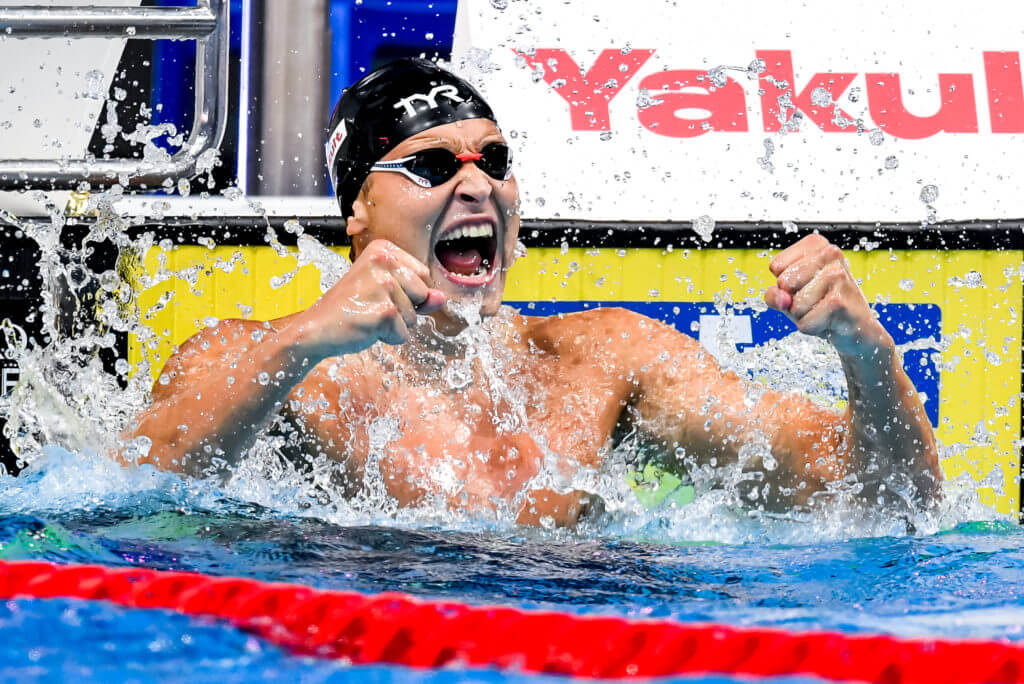Backstroke Finish Rule Needs Change After World Championships DQ Ordeal

Editorial content for the 2022 FINA World Championships coverage is sponsored by eo SwimBETTER.
See full event coverage.
Swim faster... faster, with game-changing data insight into your technique. eolab.com #eoSwimBETTER

Backstroke Finish Rule Needs Change After World Championships DQ Ordeal
It was a pure moment of triumph for two American sprint backstrokers. Justin Ress had edged out world-record holder Hunter Armstrong to win the world title in the 50 backstroke, and the two men raised their arm in celebration. But moments later, the scoreboard flipped, and Armstrong was listed as the gold medalist with Ress disqualified for fully submerging at the finish. After a confusing hour that included Armstrong accepting the gold medal and a long video review, the DQ was overturned, and Ress was reinstated as the winner. Armstrong gladly handed over the gold medal to his teammate.
The situation was resolved with the rightful winner leaving Budapest with a gold medal, but why was the Ress victory ever in doubt? Officials disqualified the 24-year-old for fully submerging at the finish as he lunged for the wall. The technique Ress utilized at the end of his race is fairly common among backstrokers, throwing the head back after the last stroke and using a final dolphin-kick motion to reach for the wall. There is considerable debate whether this motion is actually more efficient than simply reaching back on the final stroke, but Ress and his coaches clearly believed the lunging finish was best for him.
The problem only arises if a swimmer lunges so far back and ends up completely underwater. According to the official rules for backstroke, “Some part of the swimmer must break the surface of the water throughout the race, except it is permissible for the swimmer to be completely submerged during the turn and for a distance of not more than 15 meters (16.4 yards) after the start and after each turn.”
That rule was designed to prevent swimmers from gaining too much of an advantage from their underwater dolphin kicks off the start and each turn. Since the early 1990s, backstrokers have only been permitted to go 15 meters before emerging. The finish is, of course, well past 15 meters, so underwater finishes are out. Clearly the rule was not written to regulate finishes, but the wording of the rule necessitates its application, and it’s not abnormal to see backstrokers disqualified for infractions at the finish.
Well, the wording of the rule needs to change. It’s time for FINA and the other powers in swimming to rewrite the guideline so no swimmer at the World Championships or your local club meet is DQ’ed for a tick-tack infraction on a backstroke finish.
Consider most of the common reasons for a disqualification in swimming: false start (in an individual event or relay), non-simultaneous motion or touch on breaststroke or butterfly, kicking too far underwater or an extra dolphin kick on breaststroke. All of these violations provide an unfair advantage for a swimmer. A backstroke finish where the swimmer dips an inch or two underwater? No advantage — so why does this need to be a disqualifying offense?
How do you rewrite the rule so that swimmers are still prevented from kicking underwater past 15 meters. Simple: look at the guidelines used by the National Federation of State High School Associations (NFHS). The rule is almost identical to the one utilized by FINA and USA Swimming, except the last sentence reads: “After breaking the surface of the water, the swimmer must remain on the surface except for turns and finishes.”
Make an exception for finishes. It’s that simple. It will save headaches at swim meets across the world, and it will save swimmers ranging from age groupers to world-record holders (like Armstrong) from feeling like a victory was fraudulent.
This would not be the first time in recent memory that swimming has undergone a significant rule change to bring out better fairness. It has only been since 2005 that a single dolphin kick has been allowed in each breaststroke pullout, and that rule brought about much more significant change than an adjustment on backstroke finishes would.
Of course, if FINA is already making changes in backstroke, it makes sense to get rid of the delay-initiating-turn rule on backstroke, another global source of frustration. High school swimming and college swimming have dropped the rule, and it makes sense. A swimmer gliding or kicking into the wall on a backstroke flip turn would only be slowing himself or herself down. No need for a penalty if the swimmer is getting no extra advantage!
Let’s be clear: no one is suggesting there need to be massive overhauls to stroke technique. Just make some tweaks. These changes would make the sport a smoother experience for youth swimmers, masters swimmers and world champions alike, and they would help ensure that the most deserving swimmers are the ones receiving the medals.






Why not instead demand that the rules be equally applied? Video is clear that he resubmerged. Your only argument being that in your opinion resubmerging at the finish doesn’t create a competitive advantage is irrelevant. How about instead we demand competent officials who will withhold the rules as they’re written?
This only became a rule with the advent of the 15 meter rule, apparently there was some worry that swimmers would resubmerge and do fly kick at the end of the length. This not a form rule or an advantage rule just a perversion of the 15 meter rule. This puts officials of all levels in the impossible position of trying to watch the hands and the feet at the same point in time. There was no value added to the sport by this interpretation of the rule just another way to be disqualified and for one swimmer or the other to feel cheated.
Failure to initiate is so subjective between officials. I’d love to see that change.
Amen! Our LSC is notorious for over enforcing that rule, especially with age groupers learning the skill
What do you suggest this be changed to??
You could go to the HS rule.
The key word in the rule is at the FINISH which means when some part of the swimmer’s body contacts the finish wall, which like all sports you are done. I agree having competent officials observing the finish is important the call is better called by the Stroke officials as opposed to the finish official.
So what is the definition of a “finish”.
When some part of the swimmers body touches the wall after completing the specified distance. At that point the swim is over and swimmer’s body position is actually irrelevant.
Maybe it would be best to just report what happened in the race. No opinion needed.
It’s called an opinion piece. It’s literally the whole point of the article.
The application of this rule throughout club, high school, college and elite swimming is not applied uniformly and there is the rub. Changing the rule to the NFHS wording makes perfect sense — and will save a lot of needless headaches.
As simple as finishing the race on the on back with half submerged or fully submerged body is to be allowed.
As an eighties kid who was a backstroker through college I have seen learned competitive advantages nerfed to accommodate and make things easier or safer. Stand-up start? Gone. Cross-over turn? Let’s just let everyone flip to their stomach. Blast-off? Nerfed to 15 yards. If we want to talk safety? There is not a single backstroker who hasn’t cracked their wrist or forearm on the wall. Looking back and diving for the wall protects against that, so why are we worried about whether toes are out of the water?
If only we made rule changes every time an elite swimmer dq’d themselves out of a medal, or a national team spot, or a place in finals….
FWIW – NCAA adopted FINA/USA-S rules on 2017, so “delay initiating turn” is also a disqualification in college.
well .. this will promote finishing with 1 or 2 meter underwater … how will you control that ?
… or, perhaps, even more than that for a gifted and talented underwater swimmer. When “finishing” exactly began?
Finishing is defined in the rules as the moment the swimmer touches the wall, not the process approaching it.
Good point. You can adopt the point on finishing, but if they are short then you disqualify them for resubmerging PRIOR to finish.
What is defined as short? What defines approach? Sometimes laws cannot be written based on desires, they need guideposts that are based on markers that can be described in words. Hence the reason why some laws are undesirable. I suggest spending more time understanding law writing. It will change how you think about laws.
So where in the NFHS rule book does it state “After breaking the surface of the water, the swimmer must remain on the surface except for turns and finishes.”?
In the 2021-22 rule book – Rule 8 Section 2 Article 1.e last sentence “After breaking the surface of the water, the swimmer must remain on the surface (any part of the swimmer’s body is on or above the surface) except for turns;”
1.g “The finish requires completion of the required distance and contact with the touchpad or finish end by any part of the swimmer with some part of the body at or above the surface.”
Further in Situation 8.2.1 E states “submerged immediately prior to the finish touch, the swimmer is disqualified.”
After watching live and later listening to the swimmer, I better understand how difficult this call was. If his toe was out of the water by an inch the exact millisecond his lead finger touched the wall then he should not be disqualified. I think that is what happened. A few milliseconds later his big toe was underwater so he was “fully submerged’’ but by then the race was over. Impossible to distinguish that in real time and very difficult even on video replay since you can’t actually see when his lead finger touches. His long arm apparently won the race by 0.02 second but also caused his apparent disqualification. Correct video review would be require syncing the clock with the video to the 0.01 second so we could see when the toe submerged. This clearly is unrealistic for a real time decision.